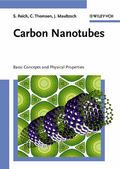Carbon Nanotubes
Basic Concepts and Physical Properties

1. Edition January 2004
IX, 215 Pages, Hardcover
126 Pictures
Monograph
Short Description
This text is an introduction to the physical concepts needed for investigating carbon nanotubes and other one-dimensional solid-state systems. Written for a wide scientific readership, each chapter consists of an instructive approach to the topic and sustainable ideas for solutions. The former is generally comprehensible for physicists and chemists, while the latter enable the reader to work towards the state of the art in that area. The book gives for the first time a combined theoretical and experimental description of topics like luminescence of carbon nanotubes, Raman scattering, or transport measurements. The theoretical concepts discussed range from the tight-binding approximation, which can be followed by pencil and paper, to first-principles simulations.
Carbon nanotubes are exceptionally interesting from a fundamental research point of view. Many concepts of one-dimensional physics have been verified experimentally such as electron and phonon confinement or the one-dimensional singularities in the density of states; other 1D signatures are still under debate, such as Luttinger-liquid behavior. Carbon nanotubes are chemically stable, mechanically very strong, and conduct electricity. For this reason, they open up new perspectives for various applications, such as nano-transistors in circuits, field-emission displays, artificial muscles, or added reinforcements in alloys.
This text is an introduction to the physical concepts needed for investigating carbon nanotubes and other one-dimensional solid-state systems. Written for a wide scientific readership, each chapter consists of an instructive approach to the topic and sustainable ideas for solutions. The former is generally comprehensible for physicists and chemists, while the latter enable the reader to work towards the state of the art in that area. The book gives for the first time a combined theoretical and experimental description of topics like luminescence of carbon nanotubes, Raman scattering, or transport measurements. The theoretical concepts discussed range from the tight-binding approximation, which can be followed by pencil and paper, to first-principles simulations. We emphasize a comprehensive theoretical and experimental understanding of carbon nanotubes including
- general concepts for one-dimensional systems
- an introduction to the symmetry of nanotubes
- textbook models of nanotubes as narrow cylinders
- a combination of ab-initio calculations and experiments
- luminescence excitation spectroscopy linked to Raman spectroscopy
- an introduction to the 1D-transport properties of nanotubes
- effects of bundling on the electronic and vibrational properties and
- resonance Raman scattering in nanotubes.
STRUCTURE & SYMMETRY
ELECTRONIC TRANSPORT
OPTICAL PROPERTIES
ELASTIC PROPERTIES
RAMAN SCATTERING
VIBRATIONAL PROPERTIES
Chip Scale Review
"... physical concepts needed to understand and investigate carbon nanotubes are introduced ..."
Materials Today
"The book gives for the first time a combined theoretical and experimental description of fundamental topics..."
Polymer News (pending)
"...is one of the most recent introductions. The internationally accredited authors have been engaged in nanotube research for several years and, additionally, international collaborations and funding for writing this book are gratefully acknowledged ... All the chapters ... offer a detailed and solid discussion of basic concepts and physical properties of this novel allotropic form of carbon. In spite of the rather complex content of the book, it can be recommended to any graduate student and practicing materials scientist, physicist, chemical physicist, and physical chemist interested in carbon nanotubes, especially those involved in nanoscience and research in nanotechnology."
Advanced Materials
"This little-over-200-page book is well organized with each chapter beginning with a brief introduction and ending with a short summary ... physicists, chemists, and material scientists who do research in this field will also find this book useful ..."
E-STREAMS
"The book gives for the first time a combined theoretical and experimental description of topics like luminescence of carbon nanotubes, Raman scattering, or transport measurements."
Zeitschrift für Kristallographie
"This book will appeal to researchers and graduate students."
Materials World
" ... it is an excellent physical textbook, which explains several fundamental aspects of one-dimensional nanoscopic systems on the basis of carbon nanotubes and then leads the reader to the frontiers of fundamental science in this field. ... the book is highly recommended not only for experts in the field of carbon nanotubes but also for scientists that are interested in the fundamental physics of one-dimensional electronic systems. In addition, it could be used as a basis for teaching a special course in physics because it is prepared in a didactically excellent manner."
small
"In summary, all the chapters of Carbon Nanotubes are solid, comprehensive discussions of the basis concepts and physical properties of this form of carbon. Each chapter begins with an excellent introduction to the topic concerned, which is followed by a good overview of the subject and more details for the expert in this area....I would recommend this book to practicing chemical physicists and physical chemists as well as to readers broadly interested in nanoscience."
Dirk M. Guldi, Inst. für Physikalische Chemie Friedrich-Alexander-Univ., Erlangen
"All of the content is easy to follow yet detailed, and usefully illustrated."
Colloid & Polymer Science


